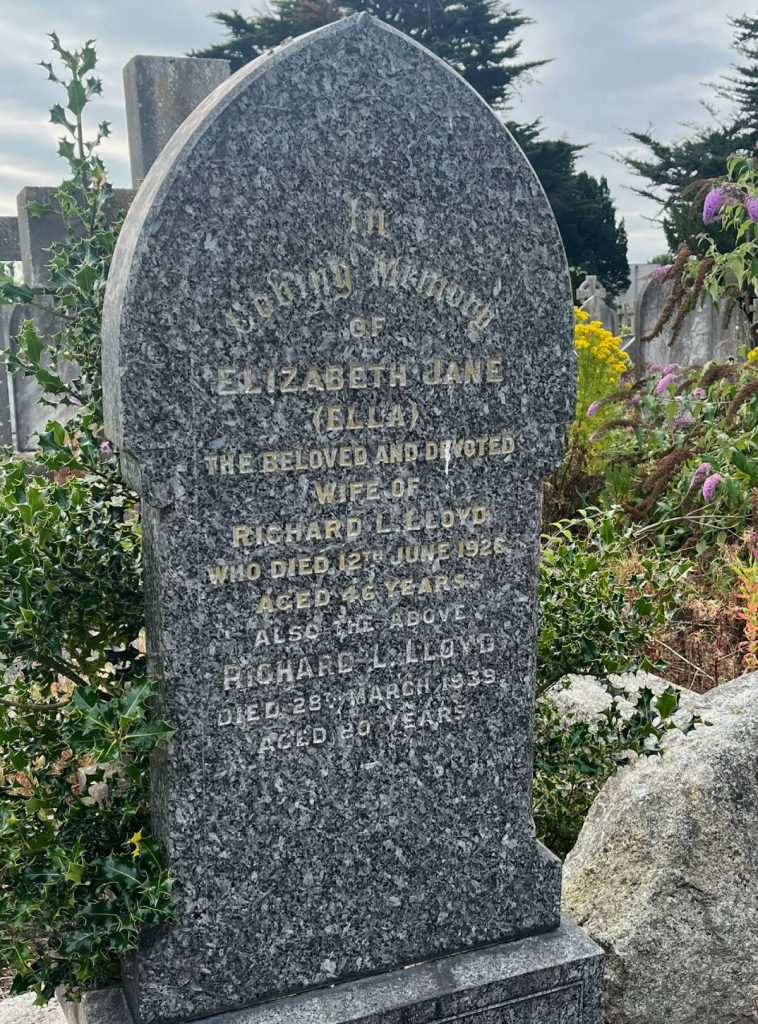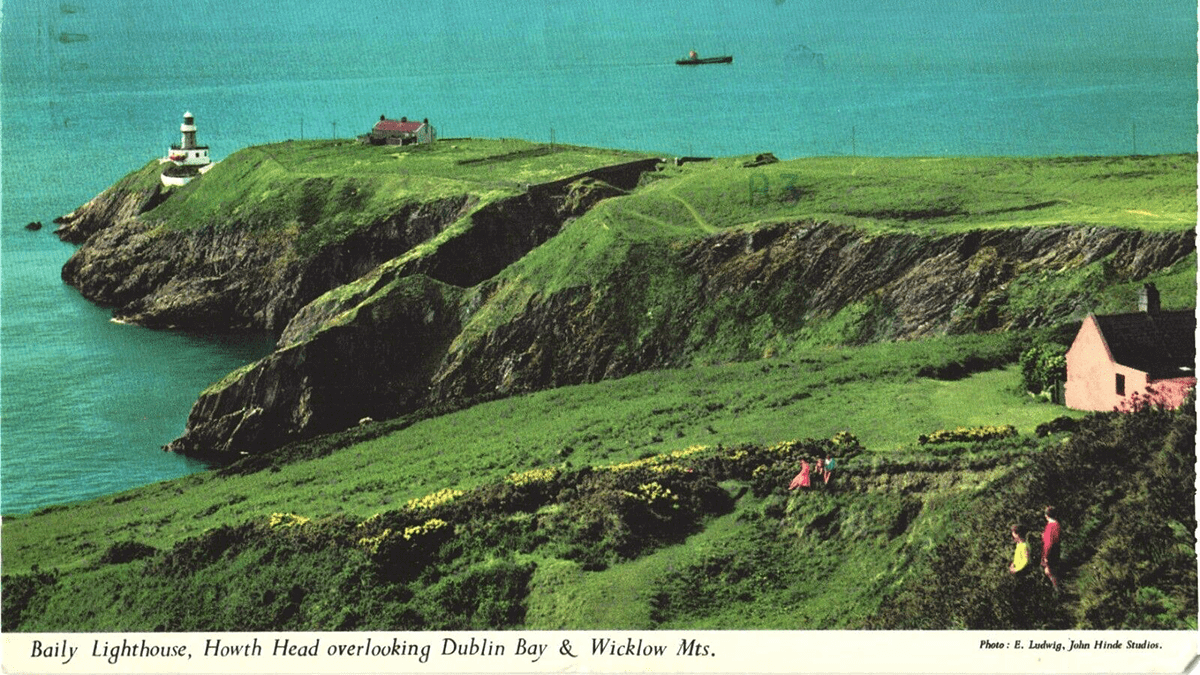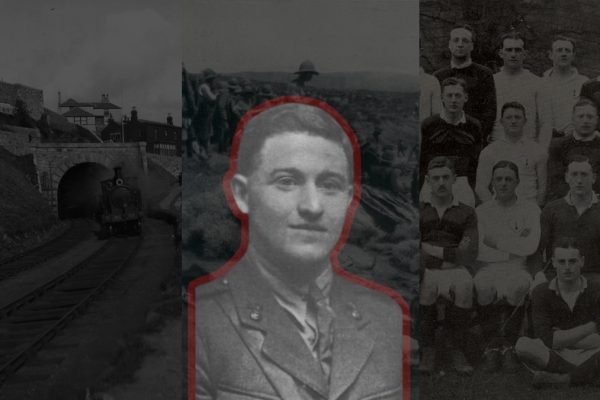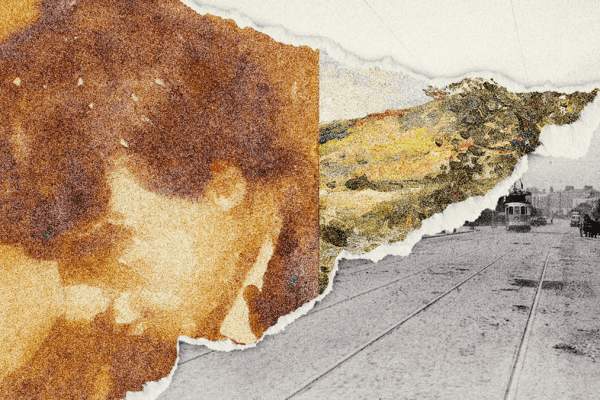New Beginnings
In 1881, at the Centenary Methodist Church in Ranelagh, Dublin, Adelaide Caroline Lloyd, of Francis Street, Dundalk, exchanged vows with Hugh Augustus Earls. Her father, Edward Longfield Lloyd, was a land agent, while Hugh’s father, William Earls, was a tailor and draper.[1] After, the couple settled into their new life and moved to Mount Vincent Villas in Limerick City, where Hugh worked as a provisions merchant.[2]
Five years later, Annie Mercer married Adelaide’s younger brother, Richard Longfield Lloyd, at St. Peter’s Church on Aungier Street, Dublin. Annie was the daughter of a merchant, living at 5 Wellington Quay, while Richard, residing at 26 Goldsmith Street, had his occupation described as a “gentleman”.[3]

Longfield Lloyd
(Credit: Linda Reid)
By 1901, life for both couples had evolved. The Earls in Limerick now had three children—a son and two daughters—though they had previously lost one son to a seizure. Hugh had transitioned from being a provisions merchant to managing Matterson’s bacon factory in Limerick.[4][5]
Meanwhile, Annie and Richard resided in Ardlui on the Dungriffin Road in Howth, Dublin. Richard was now a second-division accountant at the General Post Office (GPO). They had no children.[6]

Sudden Sorrow
Though tragedy struck on 10 August 1907. Aged 55, Hugh Earls died in Mercer’s Hospital in Dublin from a heart condition that he had been suffering with for the last few years – namely a thoracic aneurysm and aortic regurgitation – causing him to suddenly collapse.[7] The loss devastated Adelaide and led her into a severe depression. She would often say that she wished to “join her dear husband.”[8] This culminated in a suicide attempt in January 1908, when she jumped into the canal at Fitzwilliam Place in Dublin. She was rescued and confined to Highfield Asylum, an all-female private facility in Drumcondra, headed by the Quaker Eustace family.[9]

(Credit: National Inventory of Architectural Heritage)
Adelaide was discharged on 13 February 1908 and moved into Ardlui with her brother and sister-in-law, along with another widowed sister. She said that she had committed “a very foolish act” and had “no desire to repeat it.”[9]
That Fateful Day
On 16 November 1908, Richard went to his job in the GPO. At around 3:30 p.m., both Annie and Adelaide left Ardlui for a walk to buy eggs from their friend, Catherine Arnold, who lived near the Bailey lighthouse.[10] Accompanied by Annie’s Pomeranian, the duo went along the Howth cliff walk. They bought the eggs, had tea at Catherine’s house, and left about an hour later, retracing their steps along the cliff.[8]
When Richard returned home, he realised the two women hadn’t come back. He contacted Catherine Arnold, who confirmed they had already left. The coastguard was notified of the ladies’ disappearance, and Richard, together with Arnold’s son-in-law, James Moore, armed themselves with lanterns to search along the cliff path.[11]
At 11 p.m., Moore found Adelaide unconscious on a clump of ferns down the slope of the cliff. Her clothes were torn, and her hair was ragged. He threw his jacket over her and called for assistance to bring her up. She was then brought back to Ardlui.
Two men from the Royal Irish Constabulary (RIC) kept watch on the cliff during the night, with the search party continuing. As dawn broke, a coastguard boat went directly under where the struggle had taken place. There, about 140 feet below the Howth cliff path and lying precariously between the cliff and the water, was Annie’s body. Her pomeranian was found nearby, also dead.[8]
Back in Ardlui, Adelaide had regained consciousness and recounted the incident. She said that the pair were walking back along the cliffside when they were suddenly approached by two rough-looking men (described in newspaper reports as “tramps”) demanding money. The women refused and it was at this moment that the two men, enraged, threw them down the cliff, with Adelaide soon losing consciousness.[10]
This story shocked the otherwise idyllic village of Howth, and Dublin at large. The next day’s newspapers ran the sensational story, with newspaper boys calling out, “Stop Press edition. Murder of ladies at the Hill of Howth!”.[14]

reporting on Adelaide’s description of events
However, suspicion was cast over Adelaide’s story. Police noted that she was still wearing her jewellery and, additionally, two men from the coastguard were on patrol that evening, specifically going along the cliff walk. They never saw two “tramps” when the timing would have made it impossible not to have come across them.[12]
The Inquest
An inquest was held two days after the incident, on 18 November, at the courthouse in Howth, Adelaide did not attend as she had been returned to Highfield Asylum the previous night, on the certificate of two doctors, as was required.[9] It was only then, through Richard’s testimony, that it was revealed what potentially transpired. The inquest highlighted Adelaide’s previous history of mental issues, with Richard positing that his sister had a sudden suicidal episode and attempted to jump from the Howth cliff walk. In the struggle to restrain her sister-in-law, Annie overbalanced herself and fell to her death.[8] Richard wept intermittently during his testimony, stating, “She was a noble little woman and would give her life for anyone.”
The coroner for County Dublin, Christopher Friery, agreed with this theory. This was also corroborated by Dr Aherne, who described Adelaide as “of unsound mind”, lending credence that “Mrs Earl attempted to destroy herself and that the deceased tried to prevent her.”[8]

During the inquest, the jury went from the courthouse to Ardlui to view the body of Annie.[12] They returned and, without retiring, they gave their verdict: “That Annie Lloyd, aged 52, left her home on the evening of the 16th November about 4 p.m., and that her dead body on the 17th November was found at the foot of a cliff on the north-east of Howth, between Kilrock and Bailey lighthouse, she having fallen from the top of said cliff and been killed instantaneously.”[13]
One day after the inquest, Annie’s funeral was held at St. Fintan’s Church in neighbouring Sutton, and she was buried in the adjoining graveyard.[14]
Escape From Highfield
Adelaide remained in Highfield Asylum, with specific orders that, due to her suicidal tendencies, she should not be let outside the grounds of the asylum or out of sight of the nurse in charge. On 21 November, she asked if she could access her trunk in order to get some jewellery. She was allowed to, though only under the nurse’s watch. While Adelaide went through the trunk, the nurse observed her searching through the lining of the trunk and pulling out a small bottle. The nurse, Catherine Ryan, confronted her about it. Adelaide said it was Eau de Cologne. When Catherine challenged that claim, Adelaide said it was for a toothache. The bottle was later found to have contained chloroform – a potentially lethal substance that was a common method of committing suicide at the time.[15]
Adelaide referred only once to the incident on the cliffs of Howth, stating that she hoped the men who did it were caught.[9]
On Christmas Eve, 1908, Adelaide was walking around the grounds of Highfield Asylum, being watched by Catherine Ryan. Then, while turning a corner, Adelaide suddenly vanished from Catherine’s view. She searched the sheds and grounds to see if she was there, but she was gone. Adelaide had jumped over the garden wall, gone through a hedge, and emerged onto the main road. The police were notified and searches were carried out, but there was no trace of her.[9]
Three days later, on 27 December, Sergeant Michael Hanlon of the Dublin Metropolitan Police was on duty on the Anglesea Road in Ballsbridge, near the RDS, when he spotted a body floating in the water. With some help, he pulled the body out and, upon inspecting it, found a handkerchief with the name ‘Aida Earls’ on it. A ring was also found bearing her initials, while in one of her gloves was half a crown and two pence.[9][15] Her body was brought to the nearby mortuary on Londonbridge Road, where an inquest was held after her brother and sister confirmed her identity.
Richard Longfield Lloyd now sat before the inquest for the death of his sister, headed again by Christopher Friery. Here, the circumstances of Annie’s death a month prior were repeated, along with Adelaide’s well-known suicidal inclinations, including witness statements from the nurse, Catherine Ryan, and Dr Henry Eustace, the head of Highfield Asylum. The jury delivered its verdict that she had drowned and that no blame was attached to the asylum.[9]
Adelaide left behind a will, executed on 20 March 1909, bequeathing 1,105 pounds, 8 shillings, and 9 pence to her two daughters, equivalent to approximately €41,351.07 in 2024.[16]
Love After Loss
In 1913, Richard remarried in Howth to Elizabeth Davidson. Her husband, a captain in the Royal Army Medical Corps, had died in 1905 in South Africa of tuberculosis.[17][18] Richard and Elizabeth enjoyed 13 years of marriage before she died of severe intestinal inflammation.[19] Richard himself passed away in 1939, aged 79.[20] He was buried in Deansgrange Cemetery—with his second wife.

(Credit: Author)
References
- Department of Tourism, Culture, Arts, Gaeltacht, Sport and Media. “Civil Records – Marriages in Dublin South.” Irish Genealogy, n.d. https://civilrecords.irishgenealogy.ie/churchrecords/images/marriage_returns/marriages_1881/11002/8022532.pdf
- Department of Tourism, Culture, Arts, Gaeltacht, Sport and Media. “Civil Records – Births https://civilrecords.irishgenealogy.ie/churchrecords/images/birth_returns/births_1883/02729/2003971.pdf
- Department of Tourism, Culture, Arts, Gaeltacht, Sport and Media. “Civil Records – Marriages in Dublin South.” Irish Genealogy, n.d. https://civilrecords.irishgenealogy.ie/churchrecords/images/marriage_returns/marriages_1886/10827/5949101.pdf
- “1901 Census of Ireland”, County: Limerick, DED: Limerick North Rural, Townland/Street: Kilrush, House 28
- Department of Tourism, Culture, Arts, Gaeltacht, Sport and Media. “Civil Records – Births https://civilrecords.irishgenealogy.ie/churchrecords/images/birth_returns/births_1886/02586/1955967.pdf
- “1901 Census of Ireland”, County: Dublin, DED: Howth, Townland/Street: Howth, House 108
- Department of Tourism, Culture, Arts, Gaeltacht, Sport and Media. “Civil Records – Deaths https://civilrecords.irishgenealogy.ie/churchrecords/images/deaths_returns/deaths_1907/05523/4548135.pdf
- “Lady’s Tragic End at Howth,” The Irish Independent, November 18, 1908, 5.
- “Mrs. Earls’ Body Found in the Dodder,” New Ross Standard, January 1, 1909, 2.
- “Startling Occurrence in Howth,” Evening Echo, November 17, 1908, 3.
- “Howth “Sensation”,” Irish Weekly and Ulster Examiner, November 21, 1908, 5.
- “Tragedy at Howth Hill,” The Irish Times, November 18, 1908, 5.
- “Mrs. Earls’ Body Found in the Dodder,” New Ross Standard, January 1, 1909, 2.
- “Howth Hill Tragedy,” The Belfast News-Letter, November 18, 1908, 5.
- “Sequel to the Howth Tragedy,” The Daily Express, December 29, 1908, 5.
- Probate of the Will of Adelaide Caroline Earls.” March 20, 1909. Ireland Calendars Of Wills & Administrations 1858-1965. Image 160.
https://www.willcalendars.nationalarchives.ie/search/cwa/details.jsp?id=1639622608. - Department of Tourism, Culture, Arts, Gaeltacht, Sport and Media. “Civil Records – Marriages
https://civilrecords.irishgenealogy.ie/churchrecords/images/marriage_returns/marriages_1913/09890/5593023.pdf - “South Africa, Transvaal, Civil Death, 1869-1954”, , FamilySearch (https://www.familysearch.org/ark:/61903/1:1:7BW3-2KT2, Entry for James Waddell, 29 Nov 1905.
- Department of Tourism, Culture, Arts, Gaeltacht, Sport and Media. “Civil Records – Deaths
https://civilrecords.irishgenealogy.ie/churchrecords/images/deaths_returns/deaths_1926/04995/4363192.pdf - Department of Tourism, Culture, Arts, Gaeltacht, Sport and Media. “Civil Records – Deaths
https://civilrecords.irishgenealogy.ie/churchrecords/images/deaths_returns/deaths_1939/04751/4272700.pdf



